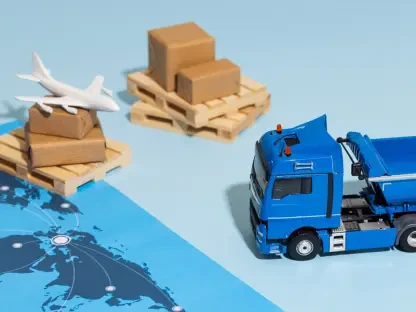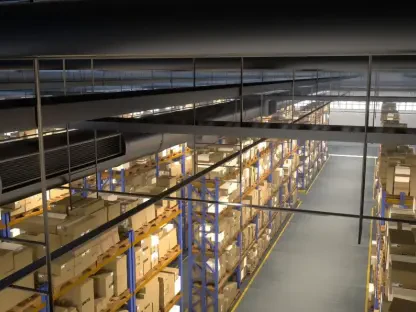In a striking move that has reverberated through the automotive and transportation industries, the United States has rolled out new tariffs on imported heavy-duty trucks, medium-duty trucks, and buses, signaling a robust stance on national security and economic protectionism. Effective since November 1, these tariffs impose a substantial 25% duty on medium- and heavy-duty trucks along with critical components like engines, transmissions, and chassis, while buses face a slightly lower 10% levy. This policy, enacted through an executive order, targets vehicles across Class 3 to Class 8 categories, encompassing a wide range of commercial and passenger transport options such as school buses, transit buses, dump trucks, and large pickup trucks. The decision underscores a broader strategy to safeguard domestic industries and critical infrastructure, raising questions about the balance between protectionist measures and international trade dynamics. As global supply chains feel the strain, the implications of this policy are poised to reshape market dynamics and trade relationships in North America.
National Security as a Driving Force
The primary justification for these tariffs, as articulated by the White House, lies in the realm of national security, highlighting the indispensable role that trucks and buses play in the nation’s economy and defense. These vehicles are responsible for transporting over 70% of the country’s freight, including vital goods like food, fuel, and medical supplies, as well as military equipment during times of crisis. The executive order emphasizes that reliance on foreign imports for such critical infrastructure poses a significant risk, potentially undermining economic stability and emergency response capabilities. By imposing these duties, the government aims to bolster domestic production and reduce dependency on overseas manufacturers, ensuring that the backbone of American logistics remains under national control. This perspective reflects a growing trend of using trade policies as tools to protect strategic sectors, even at the risk of straining international partnerships.
Beyond the immediate security concerns, this policy also seeks to address long-term vulnerabilities in the supply chain that could jeopardize the nation’s resilience. The White House fact sheet clarifies that these new tariffs do not compound with existing sectoral or country-specific duties, indicating a calculated approach to avoid excessive economic disruption. However, the focus on heavy-duty vehicles reveals a specific anxiety about the potential for foreign dominance in a sector integral to both civilian and military operations. The argument is that fostering a robust domestic industry for these vehicles is not merely an economic choice but a strategic imperative. As global tensions and supply chain uncertainties persist, this move positions the U.S. to prioritize self-reliance, even as it navigates the complexities of interconnected trade networks with neighboring countries like Canada and Mexico.
Economic Balancing with Tariff Relief Mechanisms
To mitigate the potential economic fallout from these tariffs, the executive order incorporates several relief mechanisms designed to cushion the impact on businesses and maintain trade ties under existing agreements. Under the United States-Mexico-Canada Agreement (USMCA), importers of heavy-duty trucks can apply for a cap on the 25% tariff, limiting it to non-U.S. content, while medium-duty trucks meeting USMCA standards are temporarily exempt from the new duties. Additionally, manufacturers completing final assembly in the U.S. are eligible for a 3.75% annual tariff offset for five years, a measure also extended to auto manufacturers for U.S.-assembled cars until April 30, 2030. These provisions aim to encourage domestic production while acknowledging the integrated nature of North American supply chains, preventing a complete rupture in trade relationships with key partners.
Further adjustments to ease the burden include the Commerce Department’s authority to reduce existing 50% tariffs on steel and aluminum by up to half for companies in Canada or Mexico supplying U.S. car and truck manufacturers, provided the materials qualify for USMCA preferential treatment. This nuanced framework illustrates an attempt to balance protectionist goals with the realities of regional economic interdependence. Engine manufacturers are also slated to benefit from forthcoming processes for tariff relief, ensuring that critical component suppliers are not unduly penalized. While these exemptions and offsets demonstrate a pragmatic approach, they also highlight the complexity of implementing tariffs without triggering widespread price increases or supply shortages that could ultimately harm American consumers and businesses reliant on these vehicles.
Strategic Implications for Domestic Industries
The broader implications of these tariffs point to a deliberate strategy to fortify domestic industries against foreign competition, a trend evident in previous trade actions under similar national security justifications. This policy follows a Section 232 investigation initiated earlier this year, a mechanism historically used to impose tariffs on sectors like furniture and lumber, reflecting a consistent reliance on security concerns to justify trade restrictions. By targeting trucks and buses, the government signals a prioritization of industries deemed essential to both economic vitality and national defense, aiming to stimulate job growth and manufacturing capacity within U.S. borders. This protectionist stance, while potentially beneficial for local producers, raises questions about long-term competitiveness and innovation in a globalized market.
Moreover, the tariffs underscore a tension between safeguarding national interests and maintaining harmonious trade relations, particularly with allies under the USMCA framework. The White House acknowledges the interconnected supply chains across North America, as evidenced by the tailored relief mechanisms, yet the overarching goal remains clear: to reduce reliance on imported vehicles that could pose risks during geopolitical or economic crises. This approach may encourage foreign manufacturers to shift assembly operations to the U.S. to qualify for exemptions, potentially boosting local economies. However, it also risks escalating costs for end users if domestic production cannot scale quickly enough to meet demand, illustrating the delicate balance between security-driven policies and market realities that policymakers must navigate in the coming years.
Reflecting on a Protective Legacy
Looking back, the implementation of these tariffs on trucks and buses marked a significant chapter in the U.S. effort to shield critical industries from external vulnerabilities, driven by a deep-seated concern for national security. The executive order, with its blend of stringent duties and strategic exemptions, captured a moment of recalibration in trade policy, striving to protect domestic manufacturing while preserving key alliances under agreements like the USMCA. As the effects unfolded, the focus on heavy-duty vehicles as linchpins of infrastructure and defense resonated as a defining rationale, even as economic ripples challenged businesses and consumers alike. Moving forward, the legacy of this policy offers a blueprint for future trade measures, suggesting that targeted relief and regional cooperation could serve as vital tools in softening the impact of protectionism. Policymakers might consider refining these mechanisms further, ensuring that security imperatives align with sustainable economic growth and global trade harmony.









